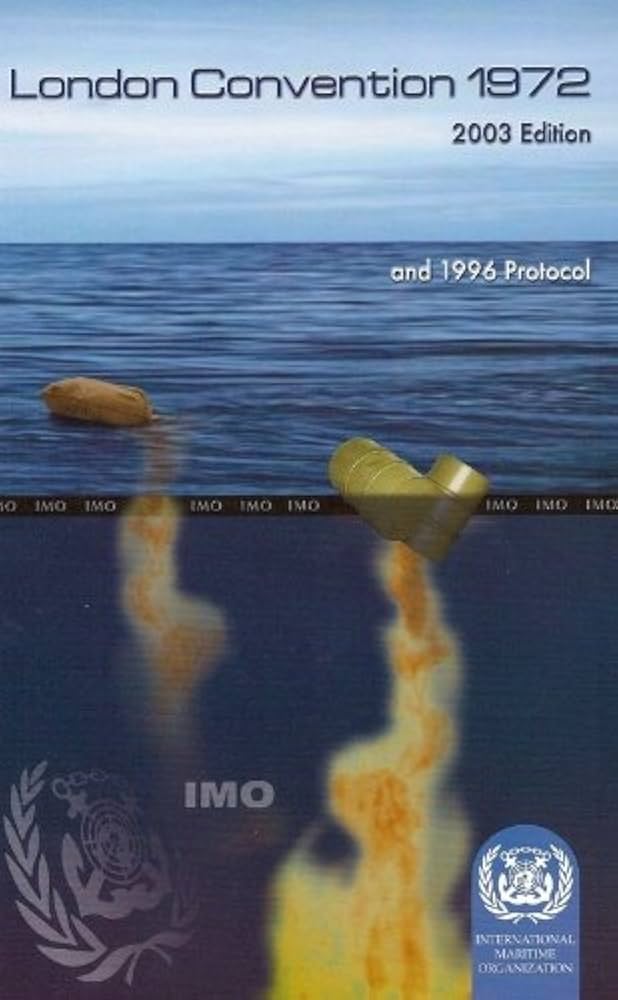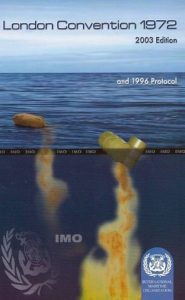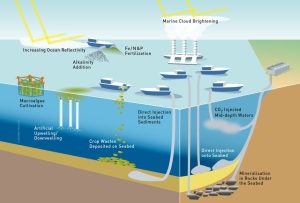Protecting Our Oceans from the Hidden Threats Beneath the Surface
When Waste Meets Water
Every year, an estimated 12 million tonnes of plastic waste and millions of tons of industrial and radioactive materials risk entering our oceans. While much attention goes to oil spills or plastic pollution from ships, there’s a less visible but equally harmful practice—marine dumping. Historically, the ocean was seen as a convenient dumping ground. But unchecked waste disposal has long-term consequences for marine biodiversity, food safety, and human health.
To confront this, the Convention on the Prevention of Marine Pollution by Dumping of Wastes and Other Matter—commonly known as the London Convention—was adopted. This article provides a detailed exploration of the London Convention, from its origins and scope to real-world applications and future relevance. It is designed for beginners, students, professionals, and general readers, using clear, globally understandable English.
What Is the London Convention?
The London Convention is one of the earliest global agreements to protect the marine environment from human activities by regulating the dumping of harmful substances into the sea.
Basic Facts
-
Official Name: Convention on the Prevention of Marine Pollution by Dumping of Wastes and Other Matter
-
Adopted: November 13, 1972, in London
-
Entered into Force: August 30, 1975
-
Administered by: The International Maritime Organization (IMO)
-
Parties: 87 countries as of 2024
The Convention prohibits dumping of certain hazardous materials and requires permits for others, making it a crucial instrument in international marine environmental law.
Historical Background: Why Was It Needed?
Until the early 1970s, oceans were frequently used for the disposal of industrial, chemical, and even radioactive waste. There was no international oversight, and national laws were inconsistent.
Key Events That Triggered Action
-
Post-WWII Era: Military and industrial waste, including radioactive material, was dumped in large quantities.
-
1960s Environmental Movement: Marine scientists and activists began documenting the damage.
-
Growing Evidence of Bioaccumulation: Harmful substances were found in marine food chains, reaching human diets.
These developments led to mounting pressure for an international agreement—resulting in the 1972 London Convention.
Goals and Scope of the London Convention
The Convention aims to control and limit ocean dumping in order to prevent marine pollution, preserve biodiversity, and protect public health.
Main Objectives
-
Prevent dumping of dangerous waste into seas and oceans
-
Create a legal framework for permit-based disposal
-
Promote scientific monitoring and research
-
Encourage cooperation between member states
It covers intentional dumping from vessels, aircraft, and platforms, but does not apply to land-based runoff or operational discharges from ships (covered by MARPOL).
What Is Dumping Under the London Convention?
The London Convention defines “dumping” as:
-
Deliberate disposal of waste or other matter from ships, aircraft, or platforms
-
Deliberate disposal of vessels or platforms themselves
Excluded from this definition are:
-
Disposal due to accidents
-
Discharges from the normal operation of ships
-
Placement of matter for a purpose other than disposal (e.g., artificial reefs)
How the Convention Works: Permits and Lists
The London Convention operates on a black-list/grey-list system, categorizing substances based on their level of danger.
Prohibited Substances (Black List)
Certain substances are strictly banned from being dumped under any circumstances:
-
High-level radioactive waste
-
Organophosphorus compounds
-
Mercury and mercury compounds
-
Cadmium and cadmium compounds
-
Persistent plastics and synthetic materials
Regulated Substances (Grey List)
Other substances may be dumped but only with special permits, including:
-
Sewage sludge
-
Dredged material
-
Inert, inorganic materials
-
Fish waste or organic materials
Permits are issued based on environmental impact assessments, considering:
-
Nature of the waste
-
Quantity and location
-
Method of disposal
-
Availability of alternatives
Real-World Applications and Case Studies
Dredged Material Disposal
Ports around the world must regularly dredge sediment to maintain shipping channels. The London Convention allows this—but only after environmental evaluation. For example:
-
Singapore, one of the busiest ports, follows strict LC guidelines to manage dredged sediments during expansion projects.
-
The United States, under the Marine Protection, Research, and Sanctuaries Act (MPRSA), aligns with LC standards for coastal dredging activities.
Decommissioning Offshore Platforms
Under certain circumstances, old oil rigs or ships may be deliberately sunk to create artificial reefs. This is allowed only if the structure is cleaned and approved, ensuring no hazardous residues.
Evolution into the London Protocol (1996)
Over time, the 1972 Convention was seen as outdated. To modernize it, the London Protocol was adopted in 1996, with stronger, more precautionary approaches.
Key Differences
-
From “permissive” to “precautionary”: The Protocol bans all dumping except for a few permitted materials.
-
Carbon capture and storage (CCS): The Protocol allows regulated underwater storage of CO₂ to combat climate change.
-
Broader monitoring obligations: Countries must now monitor, report, and assess impacts of permitted dumping activities.
As of 2024, 53 countries have ratified the London Protocol. The original Convention remains in force for others.
Importance for Key Audiences
For Beginners and General Readers
The London Convention helps stop toxic waste from being dumped in oceans—protecting seafood, coastlines, and marine life. It ensures that countries don’t treat oceans as unlimited trash bins.
For Students and Researchers
The Convention offers insights into international environmental law, marine ecology, and policy analysis. It bridges legal, scientific, and diplomatic disciplines and encourages comparative studies with MARPOL or the Basel Convention on hazardous waste.
For Professionals and Experts
Environmental engineers, marine regulators, and port authorities use LC protocols in:
-
Project environmental impact assessments (EIAs)
-
National marine pollution control frameworks
-
Dredging operations and coastal infrastructure
-
Waste management strategies for offshore industries
Challenges and Current Debates
While effective, the London Convention and Protocol face significant hurdles.
Major Challenges
-
Enforcement gaps: Not all countries have the capacity to monitor or enforce dumping rules.
-
Jurisdictional complexity: In international waters, identifying and prosecuting violators can be difficult.
-
Emerging pollutants: Microplastics, pharmaceuticals, and nanomaterials are not fully addressed yet.
-
Climate engineering debates: Geoengineering practices, such as ocean fertilization, raise legal and ethical questions under the LC/LP framework.
To remain effective, the Convention must evolve with science and international consensus.
Future Outlook: Toward a Cleaner Ocean
The London Convention continues to play a central role in global marine protection, especially as ocean ecosystems face threats from pollution, climate change, and deep-sea industrial activities.
What’s on the Horizon?
-
Enhanced digital monitoring using satellite tracking and AI for illegal dumping detection
-
Expansion of the Protocol’s scope to address emerging pollutants
-
Capacity-building programs for developing nations to implement LC/LP obligations
-
Stronger integration with the UN Sustainable Development Goals (SDG 14: Life Below Water)
FAQs – People Also Ask
What is the main goal of the London Convention?
To prevent marine pollution by regulating the dumping of wastes and other materials into the sea.
What is the difference between the London Convention and Protocol?
The Protocol is a more modern, precaution-based version of the original Convention. It bans dumping unless specifically permitted.
Is ship-based garbage dumping regulated under the London Convention?
No, operational garbage discharge from ships is covered under the MARPOL Convention, not the LC.
Does the Convention apply to plastic pollution?
Yes, the dumping of plastics and synthetic materials is prohibited under the LC due to their long-term environmental impact.
Conclusion: A Global Commitment to Blue Planet Protection
The London Convention has been a pioneering force in redefining how we treat our oceans—not as dumping grounds, but as delicate ecosystems worthy of respect and protection. From coastal cities managing dredged waste to scientists exploring safe carbon storage, the Convention remains deeply relevant.
As the world works to fight climate change, reduce pollution, and achieve sustainable ocean use, the London Convention and Protocol offer a tested, cooperative framework that continues to evolve with time.
🌊 Call to Action:
Support efforts for cleaner oceans by learning about your country’s marine pollution policies, or explore ways your organization can align with the London Protocol. Start with these resources:
References / Further Reading
-
IMO. (1972). Convention on the Prevention of Marine Pollution by Dumping of Wastes and Other Matter
-
IMO. (1996). London Protocol
-
United Nations Environment Programme (UNEP). (2021). Marine Pollution Report
-
Center for International Environmental Law (CIEL). Geoengineering and Ocean Dumping
-
Pew Charitable Trusts. Ocean Governance and Dumping Regulations
Read More :
Convention on the Prevention of Marine Pollution by Dumping of Wastes and Other Matter
The “Convention on the Prevention of Marine Pollution by Dumping of Wastes and Other Matter 1972”, the “London Convention” for short, is one of the first global conventions to protect the marine environment from human activities and has been in force since 1975. Its objective is to promote the effective control of all sources of marine pollution and to take all practicable steps to prevent pollution of the sea by dumping of wastes and other matter. Currently, 87 States are Parties to this Convention.
50 years of the London Convention
In 2022, IMO is marking fifty years since the adoption of the London Convention. The adoption of the Convention was a major achievement, which, along with the 1972 United Nations Conference on the Environment in Stockholm, constituted the first steps to truly put the environment at centre stage and take responsibility for the harm humans have done to the ocean.
Download infographic illustrating the main steps taken under the London Convention since 1972.
Download more detailed timeline infographic here.
London Protocol 1996
In 1996, the “London Protocol” was agreed to further modernize the Convention and, eventually, replace it. Under the Protocol all dumping is prohibited, except for possibly acceptable wastes on the so-called “reverse list”. The Protocol entered into force on 24 March 2006 and there are currently 53 Parties to the Protocol.
These pages include general information for the public and for States interested in becoming Parties to the London Protocol 1996. Please click on the links to the left for further information on related issues.
Information about the Convention and the Protocol can also be found in the information leaflet (currently available in English only) which contains details on what the London Convention is, achievements to date, the potential benefits and cost of membership, a shortlist of the current activities under the instruments and their relationship with other international agreements.
The Office for the London Convention/Protocol and Ocean Affairs works closely with a number of international organizations and industry associations, a list can be found under the “Links and References” section to the left.
Please note that official documents for meetings under the Convention and Protocol or intersessional meetings of working groups under the instruments are only available from the IMODOCS website, at http://docs.imo.org . Registration is required to access the documents.
Text of the Convention and Protocol
The full text of the Protocol, with its 2006 amendments, and the text of the Convention can be found in the links on the right hand side. Please note that these are not certified copies of the legal texts, these can be downloaded from http://docs.imo.org, under the section “Treaties”.
What are the purpose and objectives of the London Convention and Protocol?
The objective of the London Convention and Protocol is to promote the effective control of all sources of marine pollution. Contracting Parties shall take effective measures to prevent pollution of the marine environment caused by dumping at sea (see articles I and II of the Convention and article 2 of the Protocol).
The purpose of the London Convention is to control all sources of marine pollution and prevent pollution of the sea through regulation of dumping into the sea of waste materials. A so-called “black- and grey-list” approach is applied for wastes, which can be considered for disposal at sea according to the hazard they present to the environment. For the blacklist items dumping is prohibited. Dumping of the grey-listed materials requires a special permit from a designated national authority under strict control and provided certain conditions are met. All other materials or substances can be dumped after a general permit has been issued.
The purpose of the Protocol is similar to that of the Convention, but the Protocol is more restrictive: application of a “precautionary approach” is included as a general obligation; a “reverse list” approach is adopted, which implies that all dumping is prohibited unless explicitly permitted; incineration of wastes at sea is prohibited; export of wastes for the purpose of dumping or incineration at sea is prohibited. Extended compliance procedures and technical assistance provisions have been included, while a so-called transitional period allows new Contracting Parties to phase in compliance with the Protocol over a period of five years, provided certain conditions are met.
Progress to date:
A video about the achievements of the Convention and Protocol made for the 40 year anniversay since the adoption of the London Convention in 1972, can be found here.
An extensive compilation of the events leading up to the adoption of the Convention and Protocol, as well as many of the historical documents (meeting reports, etc.), is available on the IMO Maritime Knowledge Centre website.




.jpg)